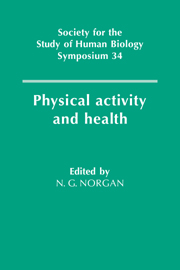Book contents
- Frontmatter
- Contents
- List of contributors
- Acknowledgements
- 1 Introduction
- 2 Comparative aspects of human activity
- 3 Physical activity levels – past and present
- 4 The validity of health measurements
- 5 Developments in the assessment of physical activity
- 6 Two national surveys of activity, fitness and health: the Allied Dunbar National Fitness survey and the Welsh Heart Health survey
- 7 Physical development and childhood activity
- 8 Physical activity and behavioural development during childhood and youth
- 9 Physiological aspects of activity and ageing
- 10 Activity and morale in later life: preliminary analysis from the Nottingham Longitudinal Study of Activity and Ageing
- 11 The benefits of low intensity exercise
- 12 Physical activity, obesity and weight maintenance
- 13 Adherence to physical activity and exercise
- 14 Women's working behaviour and maternal-child health in rural Nepal
- 15 Physical activity and psychological well-being
- 16 Leisure lifestyles: present and future
- Index
12 - Physical activity, obesity and weight maintenance
Published online by Cambridge University Press: 05 December 2011
- Frontmatter
- Contents
- List of contributors
- Acknowledgements
- 1 Introduction
- 2 Comparative aspects of human activity
- 3 Physical activity levels – past and present
- 4 The validity of health measurements
- 5 Developments in the assessment of physical activity
- 6 Two national surveys of activity, fitness and health: the Allied Dunbar National Fitness survey and the Welsh Heart Health survey
- 7 Physical development and childhood activity
- 8 Physical activity and behavioural development during childhood and youth
- 9 Physiological aspects of activity and ageing
- 10 Activity and morale in later life: preliminary analysis from the Nottingham Longitudinal Study of Activity and Ageing
- 11 The benefits of low intensity exercise
- 12 Physical activity, obesity and weight maintenance
- 13 Adherence to physical activity and exercise
- 14 Women's working behaviour and maternal-child health in rural Nepal
- 15 Physical activity and psychological well-being
- 16 Leisure lifestyles: present and future
- Index
Summary
Introduction
Obesity is recognized as a major health problem in western society. Maintenance of an acceptable body weight is therefore an important aspect of a healthy lifestyle.
Overweight and obesity result from a state of positive energy balance in which total energy intake from food has exceeded expenditure over a prolonged period. Although this equation of energy balance is simple, it has not been proved which one of the two factors, energy in or energy out, is responsible for the imbalance and the consequent high energy stores. There are many factors associated with the energy intake and expenditure and the interaction of these two factors which makes this equation complex. Furthermore, the positive balance is a gradual process over many years. In the longitudinal Zutphen study of middle-aged men over 25 years, a significant increase of 2.8kg was noticed (Kromhout et al., 1990). Assuming this to be an increase in fat stores, suggests an imbalance of about 70 MJ or 8kJ per day. With the most precise methods that are available today, this imbalance is not measurable. Even if the weight increase in the upper three percentiles of this cohort of about 15 kg is considered, the imbalance on a daily basis is about 50 kJ. The precision of a 24h measurement of energy expenditure in a respiration chamber is at best in the order of 2 to 3% leading to absolute differences of 100–150kJ.
Information
- Type
- Chapter
- Information
- Physical Activity and Health , pp. 160 - 169Publisher: Cambridge University PressPrint publication year: 1992
